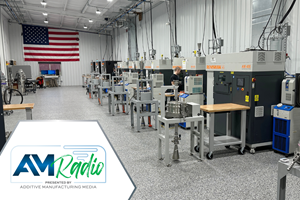Replique Enhances 3D Printing Material Hub, Expands Production Network With Traditional Technologies
Formnext 2024: Replique has also collaborated with several health care providers to develop 3D printed innovations such as a fully 3D printed containment valve and new rollator with a 3D printed frame.
Share
Replique’s Material Hub for 3D printing now offers a direct comparison feature, enabling users to easily assess materials side-by-side and quickly choose the best option for their applications. Source (all images): Replique
Replique has enriched its Material Hub for 3D printing with metals and enhanced the user experience. The hub now offers a more intuitive experience with a new direct comparison feature, enabling users to easily assess materials side-by-side and quickly choose the best option for their applications. With the addition of metal materials for additive manufacturing (AM), customers can now qualify complex, high-strength parts with precision. Users can browse materials based on specific application requirements and access detailed property data to make informed decisions in a short period of time.
“The integration of metal materials and usability enhancements of our Material Hub represent another step toward democratizing additive manufacturing,” says Jan Weickel, technical sales manager and project manager of the Replique Material Hub. “We are excited to establish new partnerships with metal manufacturers at Formnext who want to make their materials available on our platform.”
The company has also expanded its Production Network to meet the diverse needs of customers by providing access to additional manufacturing technologies, such as forging, metal casting and injection molding. This expansion gives customers access to more than 250 production partners, enabling them to meet their sourcing needs with even greater flexibility.
“With this expansion, we are responding to our customers’ desire to source all their manufacturing needs — from individual parts to serial production — centrally and using the most suitable technology for each application. This enables companies to quickly adapt to any customer requirements in a complex procurement environment,” says Dr. Max Siebert, Replique CEO and co-founder.
Replique partnered with Zermec Pharma AG to develop a fully 3D printed containment valve that minimizes contamination and enhances production quality.
In addition, Replique is also partnering with Zermec Pharma AG (provider of secure powder transfer systems) to develop a fully 3D printed containment valve, specifically designed to meet the high standards of powder manufacturers and pharmaceutical companies focused on minimizing contamination and enhancing production quality.
“Thanks to the co-engineering with Replique, we were able to prototype the containment valve quickly and effectively,” says Jochen Knoll, Zermec Pharma AG chief customer officer. “From the start of development to the launch at Achema 2024, it took just four months. The material we used is PFAS-free, meets stringent food and pharmaceutical standards, and has sliding properties similar to PTFE. This wouldn’t have been feasible with traditional CNC manufacturing.”

Replique collaborated with RehamedPower to develop a new rollator with a 3D printed frame that simplifies assembly with fewer parts and connectors.
Replique is also collaborating with RehamedPower, a provider of rehabilitation equipment. Following the successful integration of 3D printing for the RP1 electric wheelchair — from prototyping to full-scale production — it has developed a new rollator with a 3D printed frame. This design not only meets the rising demand for mobility aids that combine style with functionality but also simplifies assembly with fewer parts and connectors.
Related Content
3D Printing Solutions to Support Investment, Sand Casting
3D Systems is highlighting a design strategy for better investment casting patterns, as well as a new machine suitable for the production of patterns for sand casting.
Read MoreLooking to Secure the Supply Chain for Castings? Don't Overlook 3D Printed Sand Cores and Molds
Concerns about casting lead times and costs have many OEMs looking to 3D print parts directly in metal. But don’t overlook the advantages of 3D printed sand cores and molds applied for conventional metal casting, says Humtown leader.
Read MoreSouthern Indiana’s Thriving AM Part Producer — What I Saw at Innovative 3D Manufacturing: AM Radio #49
Recorded just after the visit to the laser powder bed fusion contract manufacturer, here is a conversation exploring observations and impressions of this company and its metal 3D printing work.
Read MoreAMGTA Research Demonstrates Sustainable Benefits of Binder Jet 3D Printing
Research from the Yale School of the Environment shows substantial reduction in GHG over traditional casting methods.
Read MoreRead Next
New Equipment, Additive Manufacturing for Casting Replacement and AM's Next Phase at IMTS 2024: AM Radio #54
Additive manufacturing’s presence at IMTS – The International Manufacturing Technology Show revealed trends in technology as well as how 3D printing is being applied today and where it will be tomorrow. Peter Zelinski and I share observations from the show on this episode of AM Radio.
Read MoreHow Avid Product Development Creates Efficiencies in High-Mix, Low-Volume Additive Manufacturing
Contract manufacturer Avid Product Development (a Lubrizol company) has developed strategies to streamline part production through 3D printing so its engineering team can focus on development, design, assembly and other services.
Read MoreCarnegie Mellon Helps Industry, Students Prepare for a Manufacturing Future with AM and AI
Work underway at the university’s Next Manufacturing Center and Manufacturing Futures Institute is helping industrial additive manufacturers achieve success today, while applying artificial intelligence, surrogate modeling and more to solve the problems of the future.
Read More











